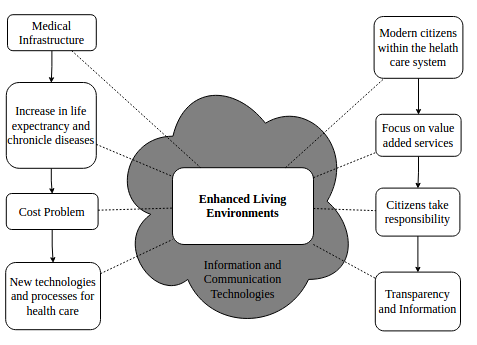
Many people believe the reasons for the increasing interest in Ambient Assisted Living (AAL) application are twofold, the well-known demographic shift with a growing share of elderly in the population, and the rapid development of witlessly connected embedded sensor devices in combination with efficient Information Technology (IT). The focus for the research on AAL has been technical systems, infrastructures, and services to support elderly people in their daily routine, to allow an independent and safe lifestyle as long as possible, via the seamless integration of Information and Communication Technologies (ICT) within homes.
For INDOOR ASSISTANCE, applications can be classified as:
- Autonomy Enhancement Services: Assistance for activities such as cooking, cleaning, drinking, dressing, eating, and medication;
- Comfort Services: Logistic services, services for finding things, and infotainment services;
- Emergency Treatment Services: Emergency prediction, emergency detection, and emergency prevention.
For OUTDOOR ASSISTANCE, applications can be classified as:
- Autonomy Enhancement Services: Assistance for activities such as shopping, traveling, and baking;
- Comfort Services: Transportation services, and orientation services;
- Emergency Treatment Services: Emergency prediction, emergency detection, and emergency prevention.
To illustrate better the different aspects of such applications, I will mention below several AAL/Enhanced Living Environments (ELE)projects.
For prevention and management of chronic conditions of elderly people, projects as ALADDIN(www.aladdin-project.eu) developed an integrated solution for the self-management of dementia patients, together with the tools to support such a procedure. The result is an integrated platform enabling distant monitoring of patient status and facilitating personalized intervention and adoptive care.
Similarly, DOMEO(www.aal-domeo.eu) developed assisted robotic technology for the integration and adaption of personalized home care services, as well as cognitive and physical assistance.
To help and support older persons live a more independent life, the project GOLDUI(www.goldui.eu) developed a Cloud-based platform, allowing older persons access online “self-serve” services and benefit from the modern digital world by using the familiar home technologies of domestic radio, TV, and telephone augmented by a mobile smartphone interface when away from the house.
Patient monitoring, another ALL/ELE direction, involves periodically transmitting routine vital signs *and, in some cases, alerting signals when ital signs cross a threshold: in other cases, the data processing of vital signs are moved on specialized in-the-Cloud platform* of patients, across certain boundaries. Still, there are many challenges in monitoring patients, including the coverage, reliability, and quality of monitoring.
Generally, AAL/ELE systems offer support for elderly people, under some form of:
- Compensation and Support: Deals with tasks supporting cognitive and physical abilities (smart walker, pedestrian GPS, etc…)
- Independent and Active Ageing: Include tasks supporting the independence of the elderly (i.e., social inclusion, work, leisure and entertainment, etc…)
- Prevention: Deals with tasks supporting and maintaining cognitive and motor abilities before severe diseases (monitoring, fall prevention…)
Figure 1 presents some factors for ELE.
Many fundamentals issues in ELE remain open. Most of the current efforts still do not fully express the power of human beings, and the importance of social connection and societal actives is less noticed. And effective ELE solutions require appropriate ICT algorithms, architectures, and platforms, having in view the advance of science in this area and the development of new and innovative connected solutions.
